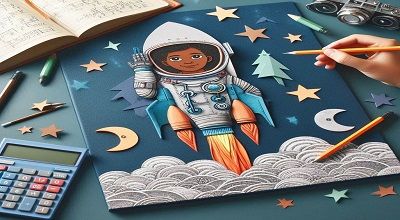Rocket Like Mae Jemison
Rocket Like Mae Jemison, the first African American woman in space, is an inspiring figure whose journey embodies courage, curiosity, and the pursuit of knowledge. This math activity will engage students in a hands-on project that combines mathematics and science, mimicking rocket design principles. Through this activity, students will learn about the mathematics involved in rocket launches, including calculations related to distance, speed, and force.
Objectives
- Understand Basic Rocket Science: Introduce students to rocket design principles and the forces acting on a rocket during launch.
- Apply Mathematical Concepts: Use mathematics to solve problems related to rocket launches, including speed, distance, and fuel calculations.
- Encourage Critical Thinking: Foster problem-solving and critical thinking skills by allowing students to design their own rockets using mathematical principles.
Materials Needed
- Paper and pencil for calculations
- Graph paper for designing rockets
- Basic craft supplies (cardboard tubes, paper, scissors, tape)
- A ruler for measuring dimensions
- A protractor for angles
- Calculators (optional)
- Access to online resources for research
Understanding Rocket Science
1. Forces Acting on a Rocket
Before launching a rocket, it is crucial to understand the forces at play:
- Thrust: The force that propels the rocket upward, generated by the rocket engines.
- Gravity: The force that pulls the rocket back to Earth.
- Drag: The air resistance the rocket encounters as it moves through the atmosphere.
2. The Rocket Equation
The basic rocket equation can be simplified to help students understand the concept of thrust-to-weight ratio:

A thrust-to-weight ratio greater than 1 means the rocket can lift off.
Mathematical Concepts
1. Speed and Distance
To calculate the speed of a rocket, students can use the formula:

2. Fuel Calculations
Understanding how much fuel is required for a rocket is crucial. The fuel burn rate can be calculated using:

3. Design Considerations
When designing a rocket, students must consider:
- Weight Distribution: Ensuring the rocket is balanced.
- Aerodynamics: The shape of the rocket affects drag.
- Material Strength: Choosing materials that can withstand the forces during launch.
Activity Steps
1: Research Phase
Students will research the basics of rocket science, focusing on the work of Mae Jemison and the principles of thrust, gravity, and drag.
2: Design Your Rocket
Using graph paper, students will sketch their rocket designs. They must include dimensions and consider the shape for aerodynamics.
3: Calculate Required Measurements
Students will calculate the following:
- Expected Launch Height: Using the speed and time formulas.
- Fuel Requirements: Based on their thrust calculations.
4: Build Your Rocket
Using the provided materials, students will construct their rockets. They should ensure their designs incorporate their calculations for weight distribution and balance.
5: Launch and Measure
Conduct a launch session where students can test their rockets. They should measure the distance traveled and the time taken to calculate the speed.
6: Analyze Results
After launching, students will compare their results with their calculations. They will discuss what worked, what didn’t, and how they can improve their designs.
Download Activity In PDF Format
Conclusion
This math activity not only engages students with practical applications of mathematical concepts but also inspires them through the story of Mae Jemison. By combining creativity with critical thinking, students can appreciate the intersection of math and science in real-world applications.
FAQs
1. What age group is this activity suitable for?
This activity is suitable for middle school students (grades 6-8) but can be adapted for older or younger students depending on their mathematical proficiency.
2. What materials are needed for the rocket construction?
Basic craft supplies such as cardboard tubes, paper, scissors, tape, and any lightweight materials to create the rocket body and fins.
3. Can this activity be done indoors?
It is advisable to conduct the launch outdoors for safety reasons and to ensure ample space for the rockets to fly.
4. How can this activity be adjusted for different skill levels?
For younger students, simplify the calculations and focus on basic concepts of force and motion. For advanced students, introduce more complex calculations or even simulations using software.
5. What are some additional resources for learning about rockets?
Students can explore resources from NASA’s website, online educational platforms like Khan Academy, or books that focus on space exploration and engineering principles.
